HIT CHANNEL EXCLUSIVE INTERVIEW: September 2021. We had the honour to talk with a legendary musician: Tony Kaye. He is best known as the original keyboard player of Yes, one of the greatest progressive rock bands and stayed with them until their iconic “The Yes Album” (1971). He just released his first solo album, “End of Innocence”, inspired by the September 11 attacks. He has also been a member of Circa, Flash, Badger and Badfinger and toured with David Bowie on his “Isolar – 1976 Tour”. Read below the very important things he told us:
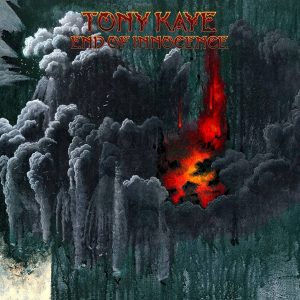 How did you come up with the idea to make an album about the September 11 attacks?
How did you come up with the idea to make an album about the September 11 attacks?
Well, of course like everyone else we woke up that day and watched what was about to transpire and stayed glued to TV for 24 hours in LA. Like everyone it hit me very hard. I hadn’t played in a long time, I had kind of retired from the music business and I went to my garage, unpacked my keyboards and started playing and that was the beginning of the album.
How challenging was it for you to describe these events musically?
I’m not sure that it was difficult. There were a couple of tracks that were challenging, that I actually recorded a couple of times. The track on the album “Flight 11” which of course was my interpretation of what I thought was happening on the planes before they crash into the towers. I debated whether to put all the transcripts of the conversations on that track. I originally left them out, then decided to put them on because it was what happened. To me, the album’s individual tracks were individual things that happened during that day. I decided that besides writing about the day, I would write beyond: What happened with the war that transpired. I have a track on the album called “The Battle”; it certainly was a difficult track to record.
I love the atmospheric piano sound of “Let’s Roll”. What was the musical vision you had on this track?
The truth of that track was that it was recorded live. I was playing in a band, myself and Billy Sherwood, who is now the bass player with Yes, we had a band starting out in about 2008 called Circa. We actually decided to go to Japan just after the tsunami that hit Northern Japan. I had a little keyboard solo spot and I had written the essence of that piano thing and it was recorded live that night in Tokyo.
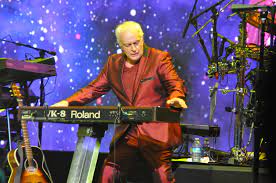 Would you like to tell us a few words about the contribution of your wife Dani Torchia (vocals) and Jay Schellen (drums -Circa, Yes) on “End of Innocence” album?
Would you like to tell us a few words about the contribution of your wife Dani Torchia (vocals) and Jay Schellen (drums -Circa, Yes) on “End of Innocence” album?
Yes, my wife Dani, who is a big Greek fan, by the way. She loves Greek and she speaks a little Greek. Barring all this Covid stuff in terms of travelling, we are hoping to get to Greece next year. I met Dani, who became my wife, two weeks after 9/11 event. She is a musician, singer/songwriter and we started to record some of her songs. I wrote this song -it’s really a dedication to the first responders, firefighters and policemen who lost their lives that day trying to save people. I was particularly struck by some video images of these distraught first responders. She came up with “Sweetest Dreams” who will actually be the next video single. It is probably released next week. Of course, Jay has been a longtime friend of mine. He is now the second drummer in Yes, subbing sometimes for Alan (ed: White -drums). Fortunately, I got to play on their 50th anniversary of Yes a couple of years ago, we met up and it was great playing with Jay. I ‘ve known him since he was 17 years old, he’s a great drummer and I really wanted a drum solo in the beginning of “Flight 11” to start the emotional intensity of that track and he’s a fantastic drummer to do that.
Roger Dean (Yes, Asia) made the artwork for “End of Innocence” album. Did you give him any particular directions?
Roger of course painted the cover for my first album without Yes, which was the “One Live Badger” (1973) album. We met on the Yes cruise. There was a cruise out of Florida -it was canceled this year- and Roger was presenting his paintings and all his Yes artwork on Cruise to the Edge. So, we got to meet and we talked about old times and when I finished the mix of the album, I sent him because obviously Roger is the real interpretation for most of the Yes albums. He very kindly said “Yes” that he would paint something. It’s not exactly Roger Dean; I told him to do whatever he wanted. So, it’s kind of dark the painting that he came up with, but that is what it was. Beautiful.
How emotional was it for you to play again with Yes on their 50th Anniversary tour and Cruise to the Edge in 2018?
You know, I hadn’t played with the band in a long time. Actually, since 1996-97 and honestly I didn’t know whether I should do it all that but they very kindly said: “We want you to play on the end of the set for the encores” doing the songs really that came from the beginning of the band, from “The Yes Album”. We did “Yours Is No Disgrace”, “Starship Trooper”, “Roundabout”, all the old stuff and it was really a great experience I have to say.
In your opinion, what made “The Yes Album” (1971) so groundbreaking?
First of all, Steve (ed: Howe -guitar ) had just joined the band and really for the first time we were able to think about spending time recording an album. Before that, we had basically recorded on a radio station and it was a long take thing. The album was recorded on a day. [Ed: On the other hand, on “The Yes Album”] We were able to go into a studio, so we took the band to what became Steve’s house in the English countryside and wrote and rehearsed. It took a new importance, because even though Atlantic Records had stayed with us, we knew that this had to be a really good album. Thanks to Steve and everyone getting together and recording obviously with Eddy Offord over 3 or 4 months. It changed the band.
 You co-wrote “Yours Is No Disgrace” from “The Yes Album”. Could you please tell us everything we should know about this beautiful song?
You co-wrote “Yours Is No Disgrace” from “The Yes Album”. Could you please tell us everything we should know about this beautiful song?
Yes, quite a few of the song inspiration has come from me and Steve driving around the English countryside in a car, with Steve and his acoustic guitar out of the car window, composing things. That’s really how a lot of “Yours Is No Disgrace” was instigated, but quite a few of the other songs, too. It was being in the country and being free. It was a very good atmosphere to be able to write.
Is it flattering that Tony Banks (keyboards) from Genesis said on a Rolling Stone interview that he loved “The Yes Album” (1971) and he preferred the band when you were a member of?
I mean, I always loved Tony. That’s very kind of him. I didn’t know that, but I’ll give him a ring and send him a check.
Why did you leave Yes after the release of “The Yes Album”?
Probably we don’t have enough time to really go into the reasons, but there were many reasons. The band was going in a different direction. I was not really fond of the mini-Moog and the mellotron that they really wanted to incorporate in the band, which of course Rick (ed: Wakeman) was great to play with. I was really a Hammond player who just really wanted to play the Hammond and probably the fact that I did have my own band right at the end of that, so it was a sort of a mutual, natural progression. Of course, I got to record with my band “One Live Badger” supporting Yes, so it all went quite well.
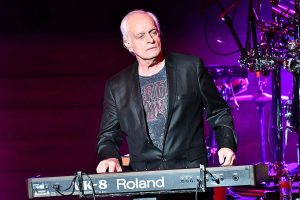 Did you feel comfortable with the musical direction of Yes’ “90125” album (1983)?
Did you feel comfortable with the musical direction of Yes’ “90125” album (1983)?
Yes, it was a different time, a different decade, a different era. We were all in London inspired by the different things that were going on in London and of course inspired by the music and some writing of Trevor Rabin (guitar, vocals). I mean, I know that there are certain Yes fans who would prefer the ‘70s band and the ‘70s music, but it is what it was and a lot of people liked it. Of course, it was very successful, very popular and we all had a good time.
I guess it would be really weird to do the Union Tour (1991-92) with Yes. What memories do you have from that tour?
I love “Union”. It was a very enjoyable tour. Of course, it came after an album (ed: “Union” -1991) that it was very fractured and split up between two different entities (ed: ABWH and then Yes line-up). You know, the record company executives wanted to make it happen and it did and we were actually able to play all of the Yes catalogue including “Big Generator” (1987), “90215”, the “Union” album and a lot of the ‘70s music with 8 people. So, it was very satisfactory on tour and I had a great time.
What does the 2017 Rock and Roll Hall of Fame induction of Yes mean to you?
I guess it was very satisfying. It hadn’t been in a long time and really I don’t think anyone was speculating on ever becoming any part of the Rock and Roll Hall of Fame. So, it was a nice surprise when it happened.
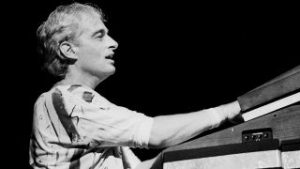 I’m a big fan of “One Live Badger” (1973) album by Badger. Are you proud of this album?
I’m a big fan of “One Live Badger” (1973) album by Badger. Are you proud of this album?
I am. Actually, it was my band that I formed with David Foster, who was the bass player in Badger as you know. He was the original bass player with Jon Anderson’s (Yes -vocals) first band, the Warriors. He was a great singer, a great songwriter. We got on very well musically. So, it was a project that the fruition was obviously going to be good. The thing about “One Live Badger” was that before Yes came to town and said: “Can we borrow your equipment to rehearse for the gig?” we had only rehearsed the band for 2 or 3 weeks. So, we were very inexperienced with playing together and it was amazing really that it turned out as well as it did. So, I’m happy you like it.
How did you get Jon Anderson to co-produce “One Live Badger” album?
We were together, we supported the band I think maybe for two times, as far as I can remember, on that gig in London (ed: Rainbow Theatre, 15/16 December 1972) and he was very much in favour of wanted us to do the show. The band (ed: Yes) was recording and he very kindly suggested that we record the show. So, he was very involved with it.
You hanged out with John Bonham (Led Zeppelin -drums) every night when you moved to Los Angeles. What was he like?
Yes, when I moved to LA I was living in the Riot House (ed: Hyatt House), next door to John Bonham. I wondered where to live when I moved there and lived in the Riot House on the Sunset Strip, which was just up the road from the famous Rainbow Bar & Grill in Hollywood. We were there at least once a week or… once a night, I would say. He was a very nice guy, just down-to-earth, from Birmingham and salt of the earth, very normal, natural and not big time at all. He could be a little rough but, you know… drummer. He was a drummer.
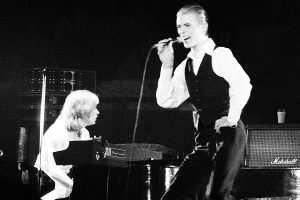 How did it happen to join David Bowie’s band in 1976?
How did it happen to join David Bowie’s band in 1976?
Just after I moved to Los Angeles, I was actually celebrating by birthday at the Rainbow Bar & Grill and bumped into David’s tour manager. He asked me whether I could be on a plane the next morning -he didn’t really told me what it was- and that a limousine would pick me up. The next thing I know, I was at Keith Richards’ house in Ocho Rios, Jamaica rehearsing with David. That was quick as that and I loved every minute.
You discovered some live recordings from your Bowie days. What was so special about these performances?
The story is that the “Station to Station” tour was not really recorded although there was a recording that was on a box set [ed: “Who Can I Be Now? (1974-1976)” -2016”] that I think we recorded at Nassau Coliseum in New York. When I was on tour I was able to get what we call “board mixes” which were never that good because the vocals are always too loud, but I used to get them to see how that band was, how the show was and how to improve. I got these board mixes from two shows: one in Paris and one at Madison Square Garden, actually two shows in Paris (ed: 17-18 May 1976) and they were really fantastic. I discovered them only maybe four years ago on cassettes and I transferred them to a digital performer and I did a little experimenting with them and saved them, but never actually dropped them to David. So, I still have them and maybe we can do something with them in the future.
Did David Bowie ever talked to you about his love for Kraftwerk?
Oh joy, yes! I mean, we spent quite a lot of time in Germany and of course he was hanging out with Iggy Pop. His character on “Station to Station”(ed: The Thin White Duke) was very much based on his German adventures. So, yes, I definitely knew it.
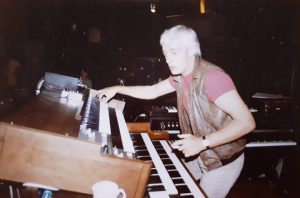 Did you meet John Lennon when you played with David Bowie?
Did you meet John Lennon when you played with David Bowie?
I got to know a lot of stars at the Madison Square Garden show (ed: 26 March 1976). Yes, there was John Lennon and all kinds of celebrities and musicians there. I don’t really remember. There were all kinds of creative people. Obviously, it was New York: painters, artists and people from the fashion business of course.
What is the secret of your lasting friendship and collaboration with Billy Sherwood (Yes, Asia, Circa -bass)?
First of all, I met Billy a long time ago, at the end of the ‘80s and we have been friends. Of course, he came on tour with the band for the “Talk” tour in the ‘90s and he was actually responsible for getting me out of retirement when I ultimately left the band. He called me and I have been playing on all kinds of session work that he was doing. We both lived in Los Angeles and we started playing together and Circa came out of that friendship.
Who are your influences as a keyboard player?
Many-many. The first show I ever went to in my hometown of Leicester, was at the Il Rondo club. An organ player had a band called The Graham Bond Organisation that included Jack Bruce (ed: bass -later in Cream) and Ginger Baker (ed: drums- in Cream too). I did a sort of a homage to them because it was my first influence and Graham Bond was my first Hammond influence. It is on the album, it is called “285 Fulton Street” and that is my homage to Graham Bond. Of course, there are many keyboard players that I love. Vangelis probably especially starting with “Blade Runner” (1982) soundtrack was a great influence. I love Vangelis.
Did you like other Hammond players from your era such as Jon Lord (Deep Purple), Gary Brooker (Procol Harum) and Steve Windwood (Traffic)?
Oh joy, yes! I mean, they are all great Hammond players too. Not to pick out any particular one, because they were all of a great influence. Rick Wright from Pink Floyd, obviously Tony Banks, the keyboard player from Gentle Giant (ed: Kerry Minnear). There were many. Of course, I always wanted to be the piano player in the Rolling Stones, which back then they didn’t have. But they didn’t call me (laughs).
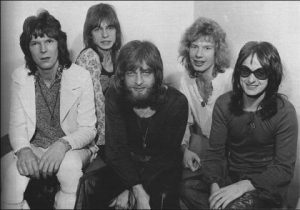 Why did you decide to move to the USA in the mid ‘70s?
Why did you decide to move to the USA in the mid ‘70s?
I guess I really liked being in America. Just before I move, I had recorded the second Badger album (ed: “White Lady” -1974) in New Orleans, and especially at that time I was very influenced by the music of the South in the US. I just loved being here. I never embarked on a plane, I never went back to England. I’ve been here for a long-long time now. At time, I really loved Los Angeles and the album of course was not very successful. The scene was kind of over for me in London and I decided to move to LA.
Are you optimistic about the future of progressive rock?
Yes! Absolutely, there are bands of course not popular on a national level because it is a music of preference which is not promoted or played on the radio. But there are a lot of new bands that are playing progressive music. So yes, I have a lot of optimism.
Do you have any regrets in your career?
No! Not one thing.
I thought that you would say signing away all your rights to Yes royalties for $10,000.
I mean, it was rectified down the line and it actually provided the money for me to come to the United States. It was a bad decision, of course, but provided the money to get me to a new life in America, which I’m a very glad of.
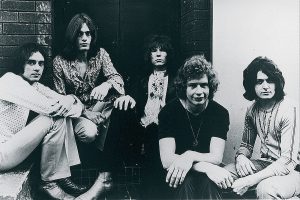 Could you describe to us in a few words the atmosphere in London in the late ‘60s when Yes performed at clubs like The Marquee and the Speakeasy?
Could you describe to us in a few words the atmosphere in London in the late ‘60s when Yes performed at clubs like The Marquee and the Speakeasy?
The Speakeasy was a very important part of our nightlife there, as with many-many clubs and of course the people, the bands, the music scene and the fashion scene, everything was as you can probably imagine. It was the place where we all started. We were young, we were 20 years old and London was an amazing place to be at that time.
Had you ever met Jimi Hendrix or Keith Moon at the Speakeasy?
Yes, I mean, I met a lot of people, but especially Keith. I loved Keith, he was a great guy. Jimi Hendrix was a really-really nice guy, I was with him at the end, actually. There were a lot of amazing people that I got to meet in London.
A huge “THANK YOU” to Mr. Tony Kaye for his time. I should also thank Billy James for his valuable help.
Buy “End of Innocence” album here: https://www.cherryred.co.uk/product/tony-kaye-end-of-innocence/
Official Yes website: http://www.yesworld.com/

